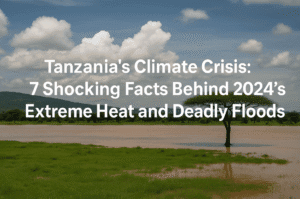In 2024, Tanzania faced an unprecedented climate crisis, marking its hottest year since record-keeping began in 1970. With nighttime temperatures surging to alarming levels and rainfall breaking decades-old records, the country’s environment, economy, and daily life were thrust into uncharted territory. Here’s a closer look at the forces behind these extremes and what they mean for a nation where most livelihoods hinge on the weather.
The Heat That Didn’t Quit: Nighttime Temperatures Steal the Spotlight
While days were hotter than usual, nights in Tanzania told a more urgent story. The national average temperature hit 24.3°C—0.7°C above normal—but the real shock came after sunset. Nighttime minimum temperatures soared to 19.3°C, a staggering 1.1°C higher than historical averages, outpacing daytime increases (which rose only 0.4°C).
- February 2024 stood out as the most anomalous month, with nighttime temps 1.5°C above average.
- From March to May, minimum temperatures consistently exceeded 1°C above normal, disrupting sleep patterns and amplifying health risks in a region with limited access to cooling infrastructure.
- The Lake Victoria Basin, Northeast Highlands, and coastal zones endured the most intense heat, straining water resources and ecosystems.
This nocturnal warming trend aligns with global patterns linked to climate change, where trapped daytime heat and humidity combine to create “silent killer” conditions, particularly in tropical regions.
Paradox of the Deluge: Wettest Year in Two Decades
Despite scorching temperatures, 2024 also became Tanzania’s fourth-wettest year on record, with 1,307.6 mm of rainfall—28% above average. The November 2023–April 2024 rainy season was the wettest since 1970, drenching the country with 172% of the typical rainfall.
- January 2024 was the wettest January ever recorded, while April ranked fifth.
- Coastal cities like Dar es Salaam and Tanga saw rainfall 3–6 times higher than normal, triggering floods that displaced thousands and damaged infrastructure.
The dual burden of heat and flooding created a lose-lose scenario: crops rotted in waterlogged fields, while soaring humidity worsened the perception of heat.
What Drove the Extremes? Climate Systems in Overdrive
Two interconnected climate phenomena conspired to destabilize Tanzania’s weather:
- El Niño: The Pacific warming phase intensified rainfall across East Africa, supercharging monsoon patterns.
- Positive Indian Ocean Dipole (IOD): Higher sea surface temperatures near Tanzania amplified moisture flow, creating a feedback loop of storms.
These systems explain why 2024’s rains were both relentless and destructive. Meanwhile, rising global greenhouse gas emissions likely exacerbated baseline temperatures, making record-breaking heat nearly inevitable.
Agriculture Under Siege: A Nation’s Lifeline at Risk
With 80% of Tanzania’s population reliant on rain-fed agriculture, 2024’s extremes exposed acute vulnerabilities:
- Floods washed away staple crops like maize and rice during critical growing phases.
- Heat stress reduced yields for coffee and tea, key export commodities.
- Waterlogging and erosion degraded soil health, compounding long-term food security fears.
The economic ripple effects are profound. Farmers faced lost incomes, while urban populations grappled with inflated food prices. Health systems also strained under spikes in malaria and heat-related illnesses.
Looking Ahead: Adaptation in a Warming World
Tanzania’s 2024 climate crisis is a snapshot of a planet in flux. As climate models predict stronger El Niño cycles and warmer Indian Ocean temperatures, the country must prioritize:
- Climate-Resilient Farming: Drought/flood-resistant crops and efficient irrigation.
- Urban Planning: Flood defenses and heat-smart housing in cities like Dar es Salaam.
- Early Warning Systems: Better forecasting to prepare for extreme weather.
The year 2024 serves as a wake-up call—not just for Tanzania but for the world. Rising nighttime temperatures and erratic rainfall are no longer distant threats; they’re today’s reality, demanding urgent, equitable solutions.
Final Thought
Tanzania’s record-breaking year underscores a harsh truth: climate change is not a uniform force. Its impacts weave a complex tapestry of extremes, challenging nations to adapt in ways that address both scalding nights and relentless rains. For Tanzania, the path forward lies in blending traditional knowledge with innovation—before the next record falls.

You must be logged in to post a comment.